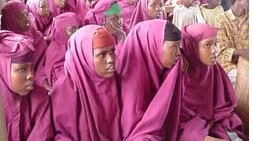Anne Gathumbi-Masheti responds to June Munala's article "Combating FGM in Kenya's Refugee Camps." (Use the link in the right sidebar to read "Combating FGM in Kenya's Refugee Camps.")
Contrary to cultural beliefs that FGM brings honor to a woman or girl’s family, FGM is one of the most dehumanizing acts of violence against women. It is often performed on young girls who lack the capacity and means to contest such a practice, which makes it even more degrading. Looking at the excuses advanced to justify its performance on innocent children, one cannot fail to notice the systematic manner in which it is used as a tool of power and control, from childhood through womanhood.
As June Munala explains, people advance various justifications to defend the practice: “It is believed to ensure virginity until marriage; it gives sexual pleasure to men and enhances their manhood; and it controls the sexual desires of women and girls.” Such explanations clearly reveal FGM as a practice that benefits men while punishing women and girls.
While any effort to combat FGM is commendable, my experience working on this issue with COVAW, a Kenyan organization that works toward the elimination of all forms of violence against women through promoting women’s human rights, has shown that no single strategy is successful on its own. Munala correctly argues that there has to be a multidisciplinary approach to the problem. But by focusing on the right to health as the most effective means for eradicating FGM, she underemphasizes perhaps the most crucial component of the struggle—the adoption of a strategy well grounded within a women’s human rights framework. Those who choose to use the human rights framework must also be alive to the reality that the traditional human rights framework has consistently failed to incorporate women’s experiences.
Despite the sensitivity of the issue of FGM, it is important that activists in this area define the principles or rules of engagement with the communities. Whereas some organizations, such as UNHCR, opt for a more subtle approach in order not to be seen as rocking the boat, it is critical to be able to name the problem to the communities. Besides describing FGM as a violation of the right to health, it is important to define it as a violation of the right to be free from gender discrimination, the right to life and to freedom from torture including the inherent dignity of the person, the right to liberty and security of the person, and the right to privacy. Only by acknowledging that the subjection of women and girls to FGM is an act of control and gender discrimination that compromises the enjoyment of their fundamental rights and freedoms can communities begin to recognize and deal with FGM as a serious violation of human rights that requires redress.
This is where the law is important, both as a regulatory mechanism and a deterrent. Munala argues that emphasizing the law is not an effective strategy because it can be punitive and can drive the practice underground in the short term. In COVAW’s work, however, we have found that repeated application of the law can, in the long run, gain acceptability as a method for addressing the problem. Legislating against FGM helps to communicate the unacceptability of the practice as well as to secure women’s rights within a legal framework and provide an option for redress.
A case in point is that of two girls in one community in Kenya who sought legal redress against their father for attempting to subject them to FGM. They obtained a perpetual injunction that barred the father from ever subjecting them to the cut. Although the girls were initially ostracized by the community, they have since been reintegrated into the family and their community, where they have continued their crusade against FGM. While initial reactions of protest in the community are to be expected, laws serve as the much-needed “shock therapy treatment” that can awaken communities to the reality that such practices are a violation of fundamental rights.
It is interesting to note the response of the refugee communities after the first case was prosecuted in the Dadaab camps: they accused the government and the international community of engaging in “petty activities.” Their attitude is that they should be left alone to continue violating women’s and girls’ rights without interference from the outside. The fact that while in the camps men expect protection from the government and the United Nations yet have a problem when that protection is extended to women and children points to a serious lack of appreciation of women’s rights as human rights. Continued prosecution can therefore provide a much-needed jurisprudential basis for the development of the law in the area of FGM and can help to reinforce the message that FGM is neither trivial nor petty.
Another strategy that has proved helpful in combination with application of the law is the alternative rite of passage. It is based on the premise that one of the positive aspects of the ceremony of FGM is educating the girls about the reproductive changes occurring in their adolescence and how to cope with those changes. The alternative rite therefore seeks to carry on the educative aspects of the practice without resorting to removing a part of the reproductive organs of the girls and women. It would be interesting to see how such an approach within the refugee camps would work as one of the strategies to combat FGM.
Given the complexity of the problem of FGM, Munala is right that adopting a multidimensional strategy is key. But above all else, those working to combat the practice must emphasize—without hesitation—the fact that FGM is a violation of women’s and girls’ rights and that these rights must be safeguarded.

